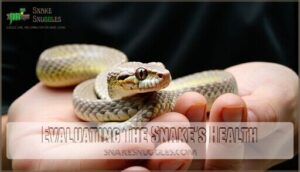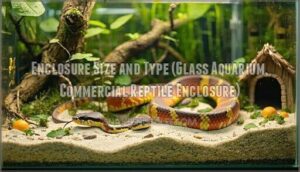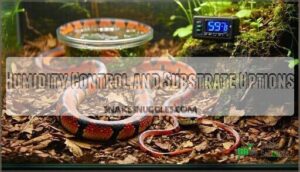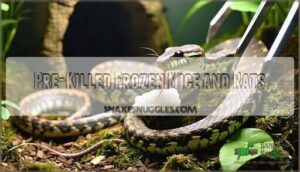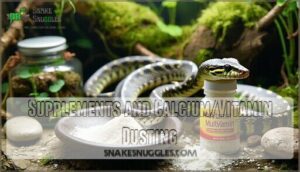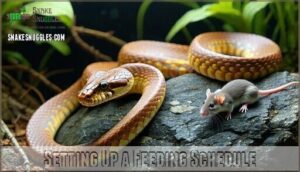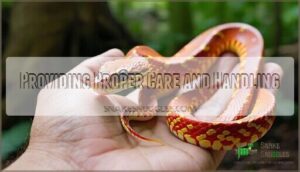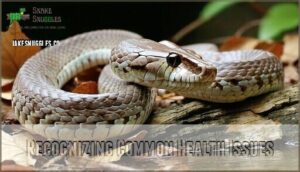This site is supported by our readers. We may earn a commission, at no cost to you, if you purchase through links.
 Learning how to adopt a corn snake isn’t rocket science, but you’ll want to do your homework first.
Learning how to adopt a corn snake isn’t rocket science, but you’ll want to do your homework first.
Start by finding a reputable breeder or rescue organization—skip sketchy pet stores that keep snakes in shoebox-sized tanks.
Look for captive-bred specimens with clear eyes, clean scales, and no mites crawling around like unwanted houseguests.
Expect to spend $50-$500 for the snake itself, plus another $300-$1000 for proper habitat setup.
These docile beauties make fantastic beginner pets, living 15-20 years with proper care.
Before you fall head-over-heels for that gorgeous morph, there’s essential prep work that separates successful snake parents from overwhelmed beginners.
Table Of Contents
- Key Takeaways
- Choosing The Right Corn Snake
- Finding a Reputable Breeder
- Evaluating The Snake’s Health
- The Cost of Adopting a Corn Snake
- Preparing a Suitable Habitat
- Understanding Corn Snake Diet and Feeding
- Setting Up a Feeding Schedule
- Providing Proper Care and Handling
- Recognizing Common Health Issues
- Frequently Asked Questions (FAQs)
- What should I give my corn snake to hide in?
- What should I do with a corn snake?
- Where can I buy a corn snake?
- How do you care for a corn snake?
- Should you adopt a snake?
- Do you need an exotic vet for a corn snake?
- How to care for a corn snake as a pet?
- How do I choose a home for a corn snake?
- Should corn snakes be kept together?
- How do you handle a corn snake?
- Conclusion
Key Takeaways
- You’ll need to budget $350-$1,500 upfront for the snake and habitat setup, plus ongoing monthly expenses of $6-20 for food and annual vet visits costing $75-150.
- Don’t buy from sketchy pet stores – find reputable breeders at reptile expos or through rescue organizations, and always choose captive-bred specimens with clear eyes, clean scales, and no mites.
- Set up a proper 40+ gallon enclosure with temperature gradients (88-90°F hot spot, 72-75°F cool side), secure hiding spots on both ends, and maintain 50-60% humidity before bringing your snake home.
- Feed pre-killed frozen mice every 5-7 days for hatchlings or 10-14 days for adults, avoid handling for 48 hours after feeding, and establish a relationship with an exotic vet since these snakes live 15-20 years.
Choosing The Right Corn Snake
You’ll want to pick a captive-bred corn snake since they’re healthier, calmer, and won’t bite your finger like they’re ordering takeout.
Consider the snake’s age, size, color morph, and sex based on your experience level, enclosure space, and whether you’re planning to breed your future slithery roommate.
Selecting a Captive-Bred Specimen
When you’re ready to adopt a corn snake, captive-bred specimens offer three major advantages over wild-caught alternatives:
Skip the wild-caught drama—captive-bred corn snakes come with better manners and fewer trust issues.
- Superior temperament traits – These snakes handle stress better and adapt quickly to human interaction
- Enhanced genetic diversity – Reputable breeders maintain healthy bloodlines, reducing hereditary issues
- Comprehensive health guarantees – Established breeders provide medical records and ongoing support for your peace of mind
Color Morphs and Patterns
Once you’ve chosen captive-bred corn snakes, you’ll discover a rainbow of possibilities in color morphs and patterns.
These Designer Morphs showcase fascinating Morph Genetics, where Pattern Inheritance creates unique combinations. Color Development varies dramatically between specimens.
Consider these corn snake adoption factors:
- Common morphs cost less than Rare Morphs ($50-150 vs $300-500)
- Pattern combinations like motley affect overall appearance substantially
- Color intensity develops fully as snakes mature over time
- Breeding potential matters if you plan future snake projects
Age and Size Considerations
Beyond gorgeous morphs, you’ll need to take into account your future snake’s age and size for successful corn snake adoption.
Hatchlings require more frequent age-based feeding but offer easier handling, while adults need less maintenance but demand larger spaces.
Planning for their adult size prevents costly enclosure upgrades later, and younger snakes typically show better temperament differences with consistent socialization.
Hatchling
Adult
Sex Determination and Importance
After selecting the right age and size, determining your corn snake’s sex becomes important for future planning.
Most beginners rely on Visual Sexing by examining tail thickness – males typically have thicker, longer tails past the cloacal opening. For accurate results, experienced keepers use the Probing Method or Popping Technique, though these require expertise to avoid injury.
Consider these Breeding Implications:
- Males may require separate housing during breeding season
- Females need extra nutrition if you plan breeding programs
- Health Differences between sexes affect veterinary care needs
Proper gender identification through scale count and understanding breeding considerations helps you prepare for your snake’s specific health implications throughout its 15-20 year lifespan.
Finding a Reputable Breeder
You’ll want to find a breeder who knows their snakes better than you know your favorite pizza order, because a good breeder makes all the difference between a healthy pet and expensive vet bills.
Think of this as snake shopping with training wheels—we’ll show you exactly what to look for, what red flags to avoid, and how to spot the difference between a reptile expert and someone just trying to make a quick buck.
Reptile Expos and Local Breeders
Reptile expos offer unmatched Expo Benefits for finding your perfect corn snake. You’ll meet passionate breeders face-to-face, examining their captivebred specimens while discussing Health Records and care practices.
These events showcase incredible Morph Availability – from classic oranges to rare morphs you won’t find elsewhere.
Look for reputable breeder setups with clean enclosures and knowledgeable staff who answer questions enthusiastically. Understanding a breeder’s commitment to ethical breeding practices is vital for ensuring animal welfare.
Breeder Reputation speaks volumes, so ask other attendees for recommendations. Ethical Sourcing matters – choose sellers who prioritize animal welfare over quick profits. It’s like shopping with expert guidance.
Pet Store Warning Signs
Not all reptile sellers have your snake’s best interests at heart.
When browsing pet stores, you’ll want to spot these pet store warning signs during your reptile adoption journey:
- Mites crawling on snakes – these tiny parasites spread disease faster than gossip
- Uninformed staff who can’t answer basic corn snake care questions
- Poor conditions with dirty enclosures and missing health records
Consider a warning corn snake sign to clearly mark enclosures.
Avoid unrealistic pricing and pushy tactics – your reptile adoption guide starts with choosing wisely.
Red Flags in Breeder Communication
Communication patterns reveal a lot about breeders. Reputable breeders welcome questions about their snakes’ health records and genetics.
A good breeder’s enthusiasm for questions tells you everything you need to know about their snakes.
However, watch for these warning signs when evaluating potential sources:
| Red Flag | What It Looks Like | Why It Matters |
|---|---|---|
| Pushy Sales | Pressure to buy immediately, won’t let you think | Ethical breeding requires patience, not quick sales |
| Unrealistic Pricing | Extremely cheap morphs or inflated rare genetics | Quality breeding costs money; too-cheap suggests corners cut |
| Missing Records | No health guarantees, breeding history, or lineage info | Genetic diversity and health tracking are breeder basics |
| Lack Expertise | Can’t answer morph rarity questions or care advice | Good breeders know their animals inside and out |
| Evasive Responses | Dodges questions about facilities or breeding practices | Transparency builds trust in ethical breeding operations |
Trust your gut—if something feels off, keep looking for better options.
Evaluating The Snake’s Health
Before you fall head-over-heels for that gorgeous corn snake at the breeder’s table, you’ll want to give it a thorough health inspection that would make a used car salesman proud.
A healthy snake shows clear, bright eyes, clean skin without mites, and an alert demeanor that says "I’m ready to be your scaly companion for the next 15-20 years.
This inspection is crucial to ensure you’re getting a healthy snake.
Clear Eyes and No Visible Injuries
A healthy corn snake’s eyes tell the whole story. Eye Clarity is your first checkpoint during health evaluation—bright, clear eyes indicate good Body Condition, while cloudiness suggests problems.
During your health check, examine every inch for injuries or abnormalities.
Injury Assessment essentials:
- Check for cuts, scrapes, or open wounds on the body
- Look for swollen areas or unusual Scale Condition
- Watch Behavioral Cues like alertness and normal movement patterns
No Mites or Ticks and a Clean Cloacal Vent
Looking beyond clear eyes, you’ll need to check for external parasites and assess vent hygiene.
During your scale inspection, look for tiny black dots that move when touched—these are mites.
Run your hands down the snake’s body, feeling for bumps or swellings. Be aware that these could indicate internal abscesses or cysts.
The cloacal vent should be clean and dry, without stuck debris.
This health evaluation catches problems early, making preventative care much easier.
Alert Head and Pink Tongue
When evaluating a potential corn snake for adoption, you’ll want to observe their alert head and active tongue flicking behavior.
A healthy snake displays clear alertness signs through confident head posture and frequent tongue movement.
Key indicators of a vibrant corn snake include:
- Head posture remains upright and responsive to movement
- Pink tongue darts out regularly, collecting scent information
- Eyes appear bright and focused on surroundings
- Quick reactions to gentle sounds or motion nearby
Checking for Signs of Dehydration
Beyond checking for that pink tongue, you’ll want to spot dehydration early.
Skin wrinkles around the neck and sunken eyes are telltale signs.
Try the turgor test – gently pinch some skin and watch it snap back.
Slow return means trouble.
Shedding issues often follow dehydration, so consider an electrolyte bath or schedule vet checkups if those clear eyes start looking dull.
The Cost of Adopting a Corn Snake
You’ll need to budget between $350 and $1,500 for your corn snake’s initial costs, which includes the snake itself and all the habitat essentials.
While the upfront investment might make your wallet feel a bit lighter, the ongoing monthly expenses of $6 to $20 for food and care make corn snakes surprisingly affordable pets in the long run, with initial costs that are manageable.
Initial Purchase Price Range ($50-$500)
Once you’ve confirmed your future pet’s health, let’s talk money. Initial purchase price for corn snakes ranges from $50-$500, making snake adoption surprisingly affordable compared to other reptile pet adoption options.
Cost depends on three Morph Cost Factors:
- Normal/wild types: $25-$50 (perfect starter snakes)
- Popular morphs: $100-$200 (butter, lavender varieties)
- Rare genetics: $300-$1000+ (palmetto, tessera bloodlines)
Breeder Reputation affects pricing, but expensive doesn’t guarantee better pets.
Habitat and Equipment Costs ($300-$1000)
Beyond the initial purchase price, you’ll face corn snake habitat setup costs that’ll make your wallet feel lighter.
Your snake enclosure setup requires careful budgeting across multiple categories.
| Essential Equipment | Price Range |
|---|---|
| Enclosure (20-40 gallon) | $50-$200 |
| Heating options & thermostat | $40-$100 |
| Substrate variety (aspen/cypress) | $15-$30 |
Snake pet supplies add up quickly.
Consider enclosure size requirements for your growing snake.
Enrichment budgets should include hide boxes, water dishes, and climbing branches.
Long-term costs consider enclosure affordability versus quality—cheap tanks often need replacing sooner.
Ongoing Expenses (Food, Veterinary Care)
After your initial habitat investment, you’ll face ongoing expenses that stack up over time.
Smart food budgeting means spending $6-20 monthly on your corn snake diet, while reptile veterinary care requires annual check-ups plus emergency funds for unexpected health issues.
Here’s your pet care costs breakdown:
- Monthly frozen/thawed prey: $6-20
- Annual vet visits: $75-150
- Emergency medical fund: $200-500
- Supplement costs: $10-25 yearly
- Long-term care upgrades: $50-100 annually
The costs are categorized into monthly, annual, and long-term expenses to help you plan your pet care costs and prepare for any emergency medical situations that may arise.
Considerations for Long-Term Commitment
Adopting a corn snake means signing up for a lifespan commitment of 15-20 years—that’s longer than most college degrees.
Your financial commitment extends beyond initial costs, requiring a steady veterinary budget for annual check-ups and emergency care.
Habitat upkeep includes replacing worn furnishings, upgrading to larger enclosures, and maintaining heating systems.
Snake ownership responsibilities involve consistent feeding schedules and temperature monitoring, which may require lifestyle changes like arranging pet care during vacations.
Smart reptile pet ownership includes emergency planning with funds set aside for unexpected health issues, making this longterm commitment both rewarding and financially demanding.
Preparing a Suitable Habitat
Creating the perfect home for your corn snake isn’t rocket science, but it’s more involved than tossing a cardboard box in the corner and calling it good.
You’ll need to set up a proper enclosure with the right temperature zones, humidity levels, and hiding spots before your new scaly friend arrives, because corn snakes are surprisingly picky about their living conditions.
This involves considering the specific needs of your pet, including providing adequate space and the right environment, which is crucial for the health and well-being of your corn snake.
Enclosure Size and Type (Glass Aquarium, Commercial Reptile Enclosure)
Your corn snake’s mansion matters more than you’d think! Choose a glass aquarium or commercial reptile enclosure that’s spacious enough for comfortable living.
Adult corn snakes need at least a 40-gallon tank, while juveniles can start smaller.
Key features for the perfect habitat setup:
- Secure, lockable lid – these escape artists will test every weakness
- Proper ventilation – fresh air prevents humidity buildup and respiratory issues
- Sturdy construction – durability guarantees long-term enclosure security and safety
Temperature Gradient and Heat Sources
Creating the perfect temperature gradient starts with placing heat mats under one side of your corn snake’s enclosure.
Set your hot spot to 88-90°F and let the cool side drop to 72-75°F.
Thermostats are non-negotiable for heat mat safety – they prevent dangerous overheating.
To guarantee proper heating, consider specialized heat products for your corn snake.
Basking bulb options work too, but always use guards to avoid burns.
Humidity Control and Substrate Options
Proper humidity control keeps your corn snake healthy and guarantees shedding success.
Maintain 50-60% humidity using moisture-retaining substrate types like cypress mulch or aspen shavings.
Place a water dish for soaking, but avoid over-misting your enclosure.
Check humidity monitoring with a digital hygrometer regularly.
Advanced keepers might consider bioactive setups, though they require more research.
Many keepers purchase pre-made snake bedding for convenience.
Too much moisture causes respiratory problems, while too little leads to stuck shed.
Find that sweet spot for ideal habitat setup.
Hiding Places and Climbing Structures
Your snake’s happiness depends on creating habitat complexity with secure hides and climbing branches.
Place one hide on each temperature side for proper enclosure enrichment.
Cork bark, sterilized branches, and artificial foliage add naturalistic design elements your corn snake craves.
Proper snake hides are essential for reducing stress.
These climbing structures satisfy their natural instincts while hiding spots provide security during your snake adoption journey.
Understanding Corn Snake Diet and Feeding
You’ll find that feeding your corn snake is surprisingly straightforward once you understand their simple dietary needs and natural hunting instincts.
Getting the prey size right and establishing a consistent feeding schedule will keep your snake healthy, happy, and ready to show off that impressive feeding response that makes even squeamish owners say "wow", which can be a truly impressive experience.
Pre-Killed Frozen Mice and Rats
Setting up your snake’s home is just the beginning – now let’s talk about feeding your corn snake properly.
Prekilled frozen mice and rats provide safe, nutritious meals without the risks of live prey. Your snake diet benefits from consistent nutritional content while you avoid dangerous bites or scratches from struggling rodents.
Sourcing options include pet stores, online suppliers, or specialty reptile vendors.
Thawing methods require careful attention:
- Move frozen prey from freezer to refrigerator overnight
- Warm in hot water before snake feeding time
- Store properly with clear storage duration labels for freshness
Feeding Frequency and Prey Size
Getting your corn snake’s feeding frequency and prey size right isn’t rocket science, but it matters.
Hatchling feeding happens every 5-7 days with prekilled frozen mice no wider than their thickest body part.
Adult portions stretch to 10-14 days with larger prey type options.
Agebased feeding prevents obesity risks and regurgitation causes through proper feeding adjustments.
Supplements and Calcium/Vitamin Dusting
Your corn snake’s nutritional needs don’t require extensive supplements since rodent prey contains sufficient calcium from bones.
However, breeding females benefit from occasional calcium dusting. Apply multivitamin powder lightly once weekly, replacing supplements every six months due to vitamin decay.
Over supplementation causes health issues, so dust sparingly. Vitamin D3 isn’t essential for most pet corn snakes.
Avoiding Live Prey and Handling After Feeding
Most corn snake owners discover that prey safety starts with frozen mice, not live ones.
This choice eliminates injury risks while maintaining full nutritional value.
After your feeding schedule, respect the digestion period—wait 48 hours before gentle interaction.
Handling stress during this time increases regurgitation risk, so let your snake digest peacefully.
Think of it as their sacred "food coma" time.
Setting Up a Feeding Schedule
You’ll want to establish a consistent feeding routine that matches your corn snake’s age, since hatchlings need meals every seven days while adults can wait 10-14 days between feedings.
Getting this schedule right from the start prevents the common mistakes of overfeeding (hello, chunky snake) or underfeeding, and helps you monitor your pet’s health and growth patterns effectively, ensuring a well-managed feeding plan for optimal growth.
Age-Based Feeding (Hatchlings, Juveniles, Adults)
Your corn snake’s feeding schedule changes as it grows, just like kids outgrowing their appetites. Hatchling feeding starts with pinky mice every 5-7 days, while juvenile portions increase to fuzzy mice weekly. Adult frequency drops to every 10-14 days with larger prey.
- Match prey size to your snake’s thickest body section
- Avoid overfeeding by sticking to consistent schedules
- Monitor growth to adjust portions appropriately
Frequency and Quantity Considerations
Once you’ve determined age-based feeding guidelines, feeding frequency becomes your next priority.
Hatchlings eat every 5-7 days, while adults wait 10-14 days between meals.
Prey size should match 1-1.5 times your snake’s thickest body width—think of it like buying jeans that fit just right.
Over/under feeding can cause serious health issues, so stick to the schedule.
During snake adoption from reptile rescue adoption centers or animal shelters, ask about the current feeding frequency to maintain consistency throughout your snake adoption process.
Monitoring and Adjusting The Feeding Schedule
Most successful corn snake owners become feeding detectives, watching for subtle changes that signal schedule adjustments.
Weight tracking reveals growth patterns, while activity changes might indicate hunger or satisfaction.
Monitor these key factors:
- Prey size progression as your snake outgrows current meals
- Regurgitation signs suggesting feeding frequency issues
- Shedding impact on appetite and feeding schedule timing
Avoiding Overfeeding and Underfeeding
You’ll want to strike that perfect balance—too much food leads to obesity, while too little stunts growth.
Monitor your corn snake’s body condition regularly; a healthy snake feels firm, not squishy or bony. Watch for regurgitation signs after overfeeding. Stick to proper prey size and feeding frequency based on age, adjusting your feeding schedule as needed through consistent weight monitoring.
The key to successful snake care is finding the right balance and being mindful of regurgitation signs, proper prey size, and maintaining a healthy snake.
Providing Proper Care and Handling
You’ll need to master gentle handling techniques and create a low-stress environment to keep your corn snake healthy and comfortable.
Think of yourself as a snake whisperer, not a snake wrestler—these calm reptiles respond best to consistent care, proper support during handling, and regular vet check-ups that’ll catch problems before they become expensive headaches.
Gentle Handling and Support
Proper corn snake handling starts with safe restraint techniques that build trust over time.
Support their body with both hands, reading body language for signs of stress. Gentle handling reduces anxiety and creates positive interactions.
Limit handling frequency to avoid overwhelming your snake. When children interact, supervise closely and teach proper support methods.
Confidence matters more than speed.
Avoiding Handling After Feeding
Hold off on handling your corn snake for 24-48 hours after feeding to prevent regurgitation risk and digestion discomfort. Your snake’s digestive process needs uninterrupted time, and disturbing them can trigger their feeding response or cause stress.
Remember that factors like meal size can affect snake digestion time.
Handling alternatives during this period include:
- Observing from outside the enclosure
- Checking water bowl cleanliness
- Monitoring temperature gradients
- Planning your next feeding schedule
Stress Reduction Techniques
Beyond avoiding post-meal handling, you’ll want to master stress reduction techniques for your corn snake’s wellbeing.
Create a quiet environment by placing the enclosure away from high-traffic areas and loud noises.
Enclosure enrichment with multiple hide boxes gives your snake security options.
Practice gentle handling and safe handling methods, moving slowly and confidently.
Gradual introduction to new experiences prevents overwhelming your pet.
Maintain regular schedules for feeding and cleaning.
When stressed, minimize interaction until your snake settles.
Think of it as snake therapy—stressfree handling builds confidence for both of you!
Regular Veterinary Check-Ups
Beyond keeping stress levels low, your corn snake needs annual examinations to stay healthy.
Think of veterinary care as your snake’s health insurance policy – catching problems early saves money and heartache later.
Here’s what regular checkups accomplish:
- Parasite screening detects intestinal invaders before they cause serious health issues
- Preventative care identifies potential problems during routine physical examinations
- Emergency protocols establish baseline health records for future specialist referrals
Recognizing Common Health Issues
Even the healthiest corn snakes can face issues like stuck shed or skin infections, and you’ll want to catch these problems early before they become serious.
Learning to spot the warning signs will help you keep your scaly friend comfortable and avoid those awkward moments when you’re explaining to the vet why you waited three weeks to bring in a snake that looks like it’s wearing a bad sweater.
This approach will help prevent minor issues from becoming major problems, ensuring your pet remains healthy and thriving, and you can enjoy your time with them without the worry of potential skin infections.
Dysecdysis (Shedding Problems)
Dysecdysis occurs when your corn snake can’t shed properly, often due to low humidity levels or supplement deficiencies.
Like peeling sunburned skin, retained skin around eyes and tail signals trouble. Monitor your snake’s shedding frequency—healthy adults shed every 6-8 weeks.
Retained eye-caps appear as cloudy patches that won’t clear. The snake shedding process needs 50-60% humidity for success.
Snake care includes providing rough surfaces for rubbing. Persistent issues require veterinary intervention to prevent infections.
Pustular Dermatitis (Skin Infections)
Another health concern you’ll encounter is pustular dermatitis, appearing as red, blister-like bumps on your snake’s belly.
These skin infections often result from excessive moisture and poor hygiene in their habitat. Bacterial infections and fungal infections can quickly escalate without proper antibiotic use and vet-recommended treatments. These infections can sometimes be traced back to poor husbandry practices.
Here are key preventative measures for ideal snake health.
- Maintain proper humidity levels (40-60%)
- Clean substrate regularly to prevent contamination
- Guarantee adequate ventilation in the enclosure
- Monitor for early signs of abscess treatment needs
- Schedule routine reptile health care check-ups
Frequently Asked Questions (FAQs)
What should I give my corn snake to hide in?
Like a cozy blanket fort, your corn snake needs secure hideouts on both the warm and cool sides of its enclosure.
Commercial reptile hides, hollow logs, or upside-down plastic containers work perfectly for these shy creatures.
What should I do with a corn snake?
You’ll need to feed your corn snake frozen-thawed rodents every 7-14 days, maintain proper temperatures, provide fresh water, and handle gently.
They’re low-maintenance pets that mostly eat, sleep, and occasionally explore their habitat, making them a great choice for those who want pets.
Where can I buy a corn snake?
Over 80% of corn snakes sold come from reptile expos and specialty breeders.
You can find them at reptile shows, online from reputable breeders, pet stores, or rescue organizations.
Always choose captive-bred specimens for better health.
How do you care for a corn snake?
You’ll need a secure 50-gallon tank with temperature gradient, hiding spots, and proper substrate.
Feed frozen rodents weekly, maintain 72-90°F temperatures, and provide fresh water.
They’re low-maintenance pets requiring minimal handling.
Should you adopt a snake?
Adopting a snake requires serious commitment—they live 10-25 years, need specialized care, and aren’t cuddly pets.
You’ll handle dead rodents, maintain precise temperatures, and find exotic vets.
Consider your lifestyle carefully.
Do you need an exotic vet for a corn snake?
Sure, regular vets can handle basic issues, but you’ll definitely want an exotic veterinarian for your corn snake.
They understand reptile-specific health problems, proper medications, and handling techniques that general practitioners simply don’t know.
How to care for a corn snake as a pet?
Set up a secure 40-gallon tank with proper heating, hiding spots, and substrate.
Feed frozen rodents weekly, maintain 75-85°F temperatures, and handle gently.
They’re low-maintenance pets requiring minimal daily care.
How do I choose a home for a corn snake?
You’ll need a secure 50-gallon tank with proper heating, hiding spots, and escape-proof lid.
Maintain 88-90°F hot spots, 72-75°F cool areas, plus adequate substrate for burrowing.
These escape artists demand vigilant enclosure management.
Should corn snakes be kept together?
No, you shouldn’t house corn snakes together.
They’re solitary creatures who prefer living alone and can become aggressive toward each other.
Cohabitation increases stress, disease transmission, and competition for resources, potentially harming both snakes’ health.
How do you handle a corn snake?
Like holding a garden hose, support your corn snake’s body with both hands.
Move slowly, stay calm, and let them settle first.
Support their weight evenly, avoid sudden movements, and handle gently for everyone’s comfort.
Conclusion
Remember, the best-laid plans often go awry without proper preparation. Learning how to adopt a corn snake successfully hinges on thorough research, finding reputable sources, and setting up appropriate habitats before bringing your new scaly friend home.
These gentle serpents reward dedicated owners with decades of companionship, but they’re not impulse purchases. Take time to evaluate costs, prepare proper environments, and understand their specific needs.
With patience and proper planning, you’ll enjoy years of rewarding snake ownership, as these creatures are not just pets, but long-term friends.


